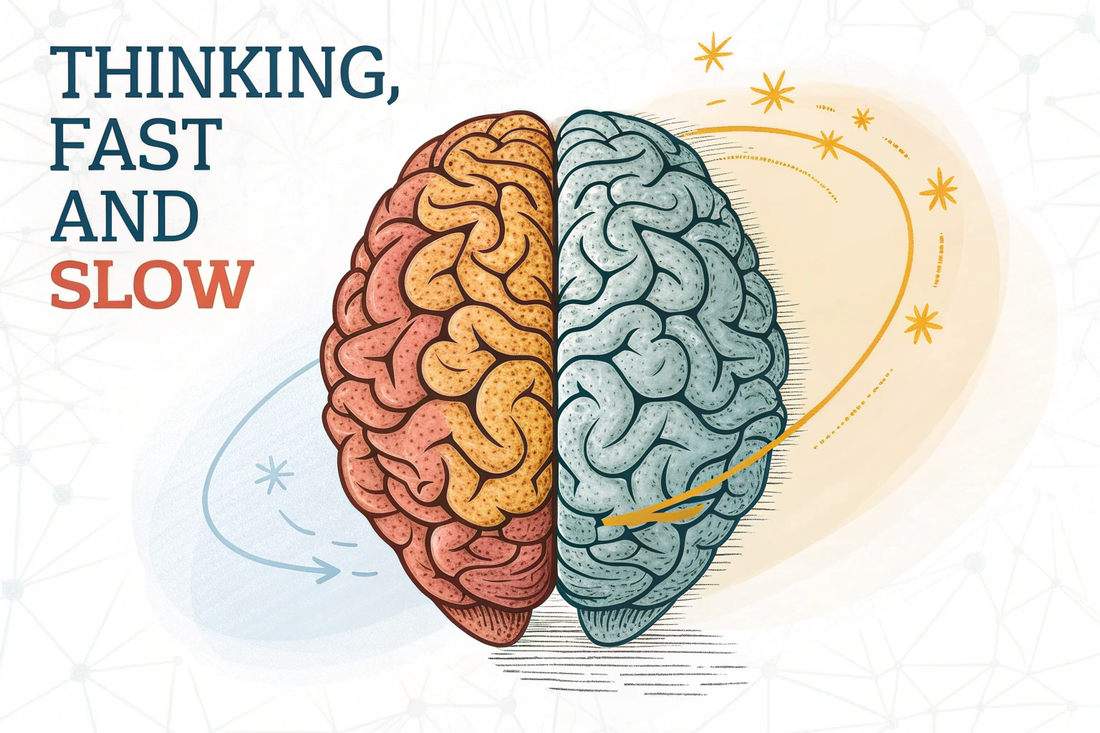
Unlocking the Secrets of Decision-Making in Thinking, Fast and Slow
Share
- Unlocking the Secrets of Decision-Making in Thinking, Fast and Slow
- Understanding the Two Systems of Thinking
- The Lightning-Quick System 1
- The Methodical Nature of System 2
- The Energy Requirements of Deliberate Thinking
- Finding Balance in Everyday Decisions
- The Freedom Collection: Empowering Mindful Decision-Making
- Common Cognitive Biases That Derail Decision-Making
- Anchoring Effect
- Availability Heuristic
- Practical Strategies for Better Decision-Making
- Creating Decision Frameworks
- Leveraging the Power of Temporal Distance
- Frequently Asked Questions About Thinking Patterns
- The Path to More Intentional Living
- Cultivating Metacognitive Awareness
Understanding the Two Systems of Thinking
Decision-making is an intricate dance between two distinct cognitive systems, a concept brilliantly illuminated in Daniel Kahneman's groundbreaking work "Thinking, Fast and Slow." As we navigate life's myriad choices—from what to wear in the morning to profound career decisions—understanding these mental mechanisms can transform our approach to judgment and choice.
The dichotomy between intuitive and deliberate thinking processes forms the cornerstone of Kahneman's thesis. System 1 operates automatically, with minimal effort and no sense of voluntary control. System 2, conversely, allocates attention to effortful mental activities, including complex computations and conscious choice-making.
The Lightning-Quick System 1
System 1 thinking—our mental autopilot—functions with remarkable celerity and efficiency. This cognitive mechanism enables us to recognize emotions in facial expressions, read words on billboards, drive on familiar roads, and make split-second judgments without conscious deliberation.
The brilliance of System 1 lies in its rapidity and evolutionary advantage. When our ancestors needed to determine whether a rustling bush concealed a predator, the luxury of lengthy contemplation wasn't available. Those whose System 1 rapidly processed potential threats survived to pass on their genes.
However, this efficiency comes with inherent vulnerabilities. System 1 falls prey to cognitive biases—mental shortcuts that, while occasionally useful, often lead to systematic errors in judgment. These heuristics sacrifice accuracy for speed, creating predictable patterns of irrationality in human decision-making.
The Methodical Nature of System 2
Unlike its impulsive counterpart, System 2 operates methodically, employing deliberate reasoning and logical analysis. When calculating complex mathematical problems, navigating unfamiliar terrain, or weighing important life decisions, we engage this slower, more resource-intensive thinking system.
In the realm of conscious decision-making, we often believe ourselves to be rational actors guided primarily by System 2. Kahneman's research, however, reveals a more nuanced reality: System 2 frequently serves as an after-the-fact rationalizer for intuitive judgments already made by System 1.
The Energy Requirements of Deliberate Thinking
System 2 thinking demands considerable cognitive resources. Each deliberate decision depletes our mental energy—a phenomenon known as ego depletion. This explains why making multiple significant decisions in rapid succession can lead to decision fatigue, wherein the quality of our choices deteriorates as mental reserves diminish.
This cognitive taxation manifests physically as well. Research indicates that blood glucose levels drop during intensive System 2 activities, highlighting the literal energy expenditure involved in deliberate thinking. The brain, despite comprising only about 2% of body weight, consumes approximately 20% of our calories—with System 2 operations requiring a disproportionate share.
Finding Balance in Everyday Decisions
The wisdom in Kahneman's work isn't about eliminating System 1 thinking—an impossible and counterproductive goal—but rather developing awareness of when each system should dominate our decision-making processes.
For routine decisions with minimal consequences, relying on intuitive judgments preserves cognitive resources for more consequential matters. However, for pivotal life choices—career changes, major investments, or relationship commitments—engaging System 2 becomes paramount.
The Freedom Collection: Empowering Mindful Decision-Making
In our quest for balanced thinking, surrounding ourselves with reminders of our values and aspirations can serve as powerful anchors. RKM Inspiration's Freedom Collection offers meaningful apparel and accessories that embody this principle, featuring designs that celebrate liberation from mental constraints and encourage intentional living.
These pieces serve as tangible reminders to pause before making important decisions, creating space for System 2 thinking when it matters most. By integrating these thoughtful designs into your daily environment, you establish visual cues that can interrupt automatic responses and prompt more deliberate consideration.
The collection's emphasis on freedom resonates perfectly with Kahneman's insights about breaking free from the limitations of unconscious biases and automatic thinking patterns that often constrain our choices without our awareness.
Common Cognitive Biases That Derail Decision-Making
Understanding the specific biases that influence our thinking provides practical leverage for improving decision quality. These mental shortcuts, while evolutionarily advantageous, often lead us astray in modern contexts.
"A reliable way to make people believe in falsehoods is frequent repetition, because familiarity is not easily distinguished from truth." — Daniel Kahneman
Anchoring Effect
The anchoring effect describes our tendency to rely too heavily on the first piece of information encountered (the "anchor") when making decisions. This bias manifests in numerous contexts, from salary negotiations to retail pricing strategies.
Consider how retailers set "original" prices artificially high to make discounted prices appear more attractive. Even when we recognize this manipulation, the initial anchor influences our perception of value. This psychological phenomenon illustrates how System 1 latches onto reference points, even arbitrary ones, to make rapid judgments.
Availability Heuristic
The availability heuristic leads us to overestimate the likelihood of events based on how easily examples come to mind. Vivid, recent, or emotionally charged memories become disproportionately influential in our risk assessments.
After media coverage of plane crashes, many people temporarily fear flying—despite its statistical safety compared to driving. System 1 rapidly retrieves dramatic imagery of aviation disasters, creating an emotional response that System 2 must deliberately counteract with statistical reasoning.
Practical Strategies for Better Decision-Making
Armed with knowledge about our dual thinking systems, we can develop practical approaches to enhance decision quality. These techniques don't eliminate our biases but create space for more balanced thinking.
Creating Decision Frameworks
Establishing structured frameworks for important decisions helps engage System 2 when appropriate. Consider this simple but effective approach:
- Define the specific decision to be made
- Identify available options and relevant constraints
- List potential consequences of each option
- Evaluate consequences against your values and priorities
- Make your choice with awareness of potential biases
This methodical process counteracts the tendency to make snap judgments based solely on intuitive responses. By externalizing our thinking, we create space for more thorough analysis.
Leveraging the Power of Temporal Distance
Creating psychological distance from decisions—particularly emotional ones—can dramatically improve outcomes. Before making significant choices, consider how you might view this decision from a future perspective.
Ask yourself: "How will I feel about this choice one year from now? Five years from now?" This temporal distancing activates System 2 and reduces the immediate emotional pull that often drives impulsive decisions.
Frequently Asked Questions About Thinking Patterns
| Question | Answer |
|---|---|
| Can we train ourselves to use System 2 more frequently? | Yes, through practices like mindfulness meditation, deliberately slowing down decision processes, and creating decision frameworks. However, the goal isn't to eliminate System 1 thinking but to recognize when deliberate thought is warranted. |
| Are some people naturally better at using System 2 thinking? | Research suggests cognitive reflection abilities vary among individuals, with some showing greater tendency toward analytical thinking. However, awareness and deliberate practice can improve anyone's capacity for reflective thought. |
| How does emotional state affect the balance between Systems 1 and 2? | Heightened emotional states typically strengthen System 1's influence while diminishing System 2's regulatory capacity. This explains why we make different decisions when calm versus anxious, angry, or excited. |
The Path to More Intentional Living
The insights from "Thinking, Fast and Slow" offer more than academic interest—they provide a roadmap for living more intentionally. By recognizing the interplay between our intuitive and deliberate thinking processes, we gain agency over our decision-making.
Cultivating Metacognitive Awareness
Perhaps the most valuable skill we can develop is metacognition—thinking about our thinking. This heightened self-awareness allows us to recognize when System 1 might be leading us astray and deliberately engage System 2 for more nuanced analysis.
The practice doesn't require constant vigilance over every mental process, which would be both impossible and counterproductive. Rather, it involves developing sensitivity to decision contexts where automatic thinking may prove inadequate or misleading.
As we cultivate this awareness, we discover that the true liberation lies not in eliminating biases but in recognizing their influence and making conscious choices about when to trust our intuitions and when to engage in deeper reflection—a balancing act that lies at the heart of wisdom itself.
